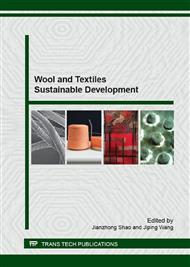[1]
Rao, A.B., et al., A technical, economic, and environmental assessment of amine-based CO2 capture technology for power plant greenhouse gas control, J. Environmental science & technology. 2002. 36(20): pp.4467-4475.
DOI: 10.1021/es0158861
Google Scholar
[2]
Abu-Zahra, M.R., et al., CO2 capture from power plants: Part II. A parametric study of the economical performance based on mono-ethanolamine, J. International Journal of Greenhouse Gas Control. 2007. 1(2): pp.135-142.
DOI: 10.1016/s1750-5836(07)00032-1
Google Scholar
[3]
Wang, Z., et al., Amine-based absorbents selection for CO2 membrane vacuum regeneration technology by combined absorption–desorption analysis, J. Chemical Engineering Science. 2013. 93: pp.238-249.
DOI: 10.1016/j.ces.2013.01.057
Google Scholar
[4]
S.H. Lin, K.L. Tung, W.J. Chen, Absorption of carbon dioxide by mixed piperazine-alkanolamine absorbent in a plasma-modified polypropylene hollow fiber contactor, J. Journal of Membrane Science. 2009. 333(1): pp.30-37.
DOI: 10.1016/j.memsci.2009.01.039
Google Scholar
[5]
Kumazawa, H., et al., Absorption and desorption of CO2 by aqueous solutions of sterically hindered 2-amino-2-methyl-1-propanol in hydrophobic micro porous hollow fiber contained contactors, J. Chemical Engineering Communications. 2000. 182(1): pp.163-179.
DOI: 10.1080/00986440008912832
Google Scholar
[6]
Okabe, K., et al., Separation and recovery of carbon dioxide by a membrane flash process utilizing waste thermal energy, J. Energy Procedia. 2009. 1(1): pp.1281-1288.
DOI: 10.1016/j.egypro.2009.01.168
Google Scholar
[7]
Tang, N., et al., Preparation and morphological characterization of narrow pore size distributed polypropylene hydrophobic membranes for vacuum membrane distillation via thermally induced phase separation, J. Desalination. 2010. 256(1): pp.27-36.
DOI: 10.1016/j.desal.2010.02.024
Google Scholar
[8]
Atchariyawut, S. et al., Effect of membrane structure on mass-transfer in the membrane gas-liquid contacting process using microporous PVDF hollow fibers, J. Journal of Membrane Science, 2006. 285. (1): pp.272-281.
DOI: 10.1016/j.memsci.2006.08.029
Google Scholar
[9]
Zhao, Z.P., et al., Concentration of ginseng extracts aqueous solution by vacuum membrane distillation. 1. Effects operating conditions, J.
Google Scholar
[10]
Zhu, H., et al., Preparation and properties of PTFE hollow fiber membranes for desalination through vacuum membrane distillation, J. Journal of Membrane Science. 2013. 446: pp.145-153.
DOI: 10.1016/j.memsci.2013.06.037
Google Scholar


